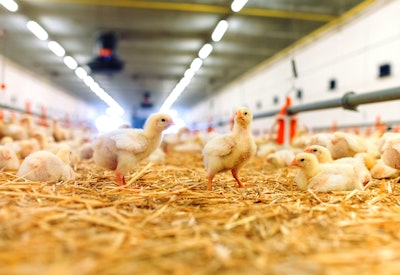
For the first time, researchers have demonstrated that there are clear differences in the frequency and style of play in male and female chicks.
“Here we show for the first time that there are clear sex differences in the age-related development of play in chickens,” said first author Rebecca Oscarsson, a Ph.D. student at Linköping University in Sweden.
“This difference is mainly because males engage more in social and object play.”
The research was published May 2 in the journal Frontiers in Ethology.
A previous study from the same researchers suggested a link between play behavior in chicks and the welfare of adult broilers.
Categorizing how chicks play
White leghorn chicks between the ages of six and 53 days old were separated by sex and given access to large arenas the researchers termed ‘playpens’ twice a week for 30 minutes of observation.
From this, the researchers categorized 12 distinct play behaviors. Locomotor play behaviors included frolicking and wing flapping. Object play featured chasing an object, pecking at an object or exchanging the object with another chick. Social play was when chicks sparred, jumped or had sparring stare-offs.
Ten minutes into the observation period, a fake rubber worm was introduced into the playpen. Worm-running, another form of object play, is when a chick carries the worm in its beak. This type of behavior models tidbitting, a courtship behavior performed by adult males to attract mates.
Both females and males demonstrated all three types of play behavior, but male chicks played more often than their female counterparts. These differences were seen especially when it came to object and social play.
Explaining the differences
The sex differences in play frequency can likely be traced back to the chicken’s ancestor, the red junglefowl. All modern poultry carry genes from the red junglefowl, which was domesticated by humans more than 7,000 years ago in Southeast Asia.
Male red junglefowl are more colorful, aggressive and vigilant than females. This sexual dimorphism means that male chicks play more to practice the skills they need as adults, the researchers hypothesized.
“We still don’t know the adaptive function of play for any species,” said author Per Jensen, a professor at Linköping University and Oscarsson’s academic supervisor.
“However, the present study indicates that a possible function is to prepare animals for specific challenges they may encounter later in life. In a species like the chicken, where only males compete for territories, it makes sense that they engage in more social play as young.”
More research is needed to further understand the relationship between play and adult behavior in chickens, the researchers said.


















